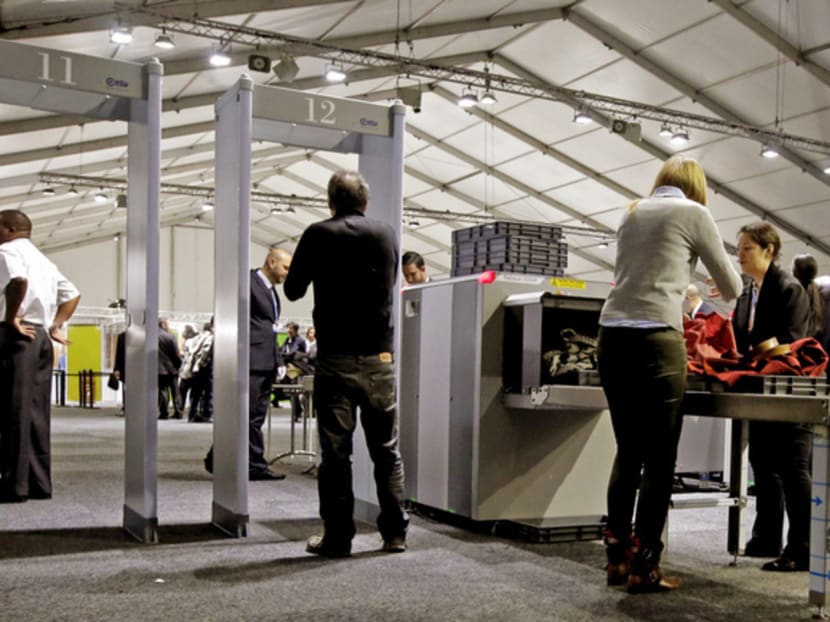Paris turns to technology in fight against terrorism
PARIS — The 46 million shoppers who annually visit the Quatre-Temps shopping centre on the edge of Paris now have their bags checked before passing through its glass portals. In the heart of the city, tourists at the Louvre are subjected to longer queues since the authorities improved safety checks at the museum.

People line up to pass a security checkpoint before entering the venue at the World Climate Change Conference 2015 (COP21) in Le Bourget, near Paris. Deputy Mayor of Paris Jean-Louis Missika says technology will play an increasingly important role both in preventing terrorist incidents and in dealing with them if they should occur. Photo: REUTERS
PARIS — The 46 million shoppers who annually visit the Quatre-Temps shopping centre on the edge of Paris now have their bags checked before passing through its glass portals. In the heart of the city, tourists at the Louvre are subjected to longer queues since the authorities improved safety checks at the museum.
Habits here are changing after 2015’s terrorist incidents: In January, three Islamist extremists murdered 17 people in targeted shootings launched against the Charlie Hebdo magazine, police and a Jewish supermarket. In November, gunmen and suicide bombers left at least 130 dead and hundreds injured.
So what is the city doing to minimise the risk of further attacks and how might this change Paris? In an interview, Deputy Mayor of Paris Jean-Louis Missika said that technology will play an increasingly important role both in preventing future incidents and in dealing with them if they should occur.
The city’s left-wing government has started a 3D-scanning programme for thousands of public and private buildings to help security forces react better to siege situations, a need that was underlined by the hostage takings that occurred during last year’s attacks.
Mr Missika said: “We have to have a much better vision of public spaces.” He added that 3D scans are “a way of visualising the entire building — inside and out — to help us deal with emergency issues”.
He said the scheme, which includes all publicly owned buildings and other selected private structures, from large offices to supermarkets, was financed publicly and privately. It costs between €3,000 (S$4,600) and €10,000 to scan each building. Local governments are also coordinating various networks of CCTV cameras. He said: “After November’s attacks we discovered that police can follow a car in Paris, but the system of cameras outside the city is different.”
Mr Missika added there are about 40,000 public and private CCTV cameras in Paris. This number is thought to lag behind London, which is one of the world’s most monitored cities. He said a seamless link between cameras is more important than numbers.
The French capital’s newly inaugurated Les Halles project — an undulating, 2.5ha roof spanning a large pedestrian area with shops and restaurants — is an example of this approach. It has a command centre where police can see all cameras in the complex, whether publicly or privately owned.
However, Mr Raffaello Pantucci, director of international security studies at London’s Royal United Services Institute (RUSI), said CCTV cameras are more useful after an attack than in preventing one. Many cameras are not monitored all the time, although there will be more regular monitoring of CCTV in places thought to be at greater risk. “Most of these cameras are recording for potential use in investigations.”
Mr Pantucci said one of the biggest challenges authorities face is big gatherings such as those that will doubtless form during France’s hosting of the 2016 European football championship this month. “There is a great fear around crowded spaces because of the high impact that an attack can have.”
Paris, one of the world’s most popular tourist cities, had about 32 million visitors in 2013, and organising queues at sporting events and attractions is a particular concern given the heightened risk of terrorism. Mr Missika said new ways must be found to manage queues “because if you create them outside buildings, they become targets for terrorism”, adding: “How you check people, and where you check them, may mark the biggest difference in the way you go about constructing public buildings in the future.”
In the meantime, Paris is trying to use innovation and technology to come up with some answers. In January, Mr Xavier Niel, the French tech and telecoms billionaire, worked with the police and the city government to organise a “hackathon” aimed at using the city’s nascent start-up scene to provide a response to terrorism.
One idea was an app, still in the making, that allows event organisers to reduce queues by using incentive schemes to persuade ticket-holders to arrive earlier. Another was a technology that could prioritise distress calls to emergency services based on background noises and stress levels in the caller’s voice.
Mr Missika said that applying technology to combating terrorism could even reduce the need for bigger changes in cities. “Digital or virtual solutions will not force you to reorganise people’s physical landscape,” he said.
But RUSI’s Mr Pantucci said one thing that is already changing is the approach by architects and urban planers to materials and so-called street furniture, such as barriers. A push towards extending the use of shatterproof glass to reduce the risk of injury from bomb explosions is now well under way in the United Kingdom and beyond, he said. Bollards to protect against vehicles carrying bombs ramming into buildings are also becoming more commonplace.
But, said Mr Pantucci, none of this is likely to be a deterrent. Terrorists were not intimidated last year when they tried to attack the Stade de France, which had many security checks in place. “At the end of the day, if they want to attack, they will try to find a way.” THE FINANCIAL TIMES






